Add this eBook to your basket to receive access to all 99 records. Our indexes include entries for the spelling boustead. In the period you have requested, we have the following 99 records (displaying 81 to 90): These sample scans are from the original record. You will get scans of the full pages or articles where the surname you searched for has been found. Your web browser may prevent the sample windows from opening; in this case please change your browser settings to allow pop-up windows from this site. Boys entering Uppingham School
(1905)
The public school at Uppingham in Rutland was founded by Archdeacon Johnson in 1584. A roll of scholars from 1824 to 1905 was edited by J. P. Graham, and published in 1906. This was a revision and updating of an 1894 edition of the roll, the great bulk of the work having been done by Mrs Mullins. The roll is arranged by year, and within each year by term of entrance, and then alphabetically by surname within each term. Each boy's name is given, surname first, with an asterisk where known (in 1906) to have died. Then there is month and year of birth, father's name (most often just surname and initials) and address (at entrance). Where the boy represented the school at Rugby football (XV) or cricket (XI), that is indicated. After the month and year of leaving the school, there is a brief summary of achievements in later life, and, where known, address as in 1906; but as late as this year, most boys were still at school and the entries are brief. From 1875 onwards the house within the school is also noted, with these abbreviations: A., Mr Constable's House; B., Brooklands; C., West Bank; E., Mr J. Gale Thring's House; F., Fircroft; Fgh., Farleigh; H., Highfield; L., The Lodge; L. H., Lorne House; M., Meadhurst; N., The Hall; R., Redgate; R. H., Red House; S., School House; and W. D., West Deyne. | Sample scan, click to enlarge
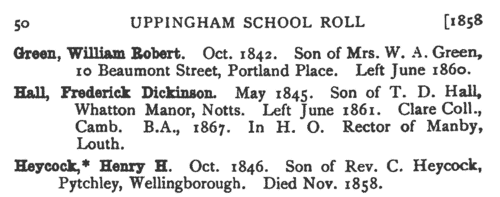
| Soldiers wounded: Lancashire Fusiliers
(1916)
Lists of names of soldiers wounded, died of wounds, died, missing presumed dead, and taken prisoner by the enemy, were issued to the British national press under the title Roll of Honour. Each man is identified by surname, initials and number. The regimental returns from which the daily Roll was compiled were made up over the previous week or weeks. Each regimental return may be partial, covering only part of the alphabet. The lists are provisional, in that a man reported wounded one day may appear as died of wounds later; a missing presumed dead may later be reported as having been found, or as having died; the lists of prisoners of war were provided by the enemy and will relate to captures weeks earlier. However, these rolls are the most comprehensive single source of names of British and allied combatants meeting with misfortune in the Great War. This is the roll published 3 August 1916. | Sample scan, click to enlarge
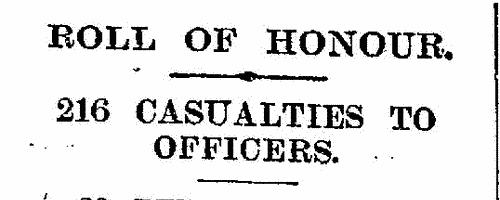
| Wanted by the police in Surrey
(1923)
The Police Gazette was published by Authority by the London Metropolitan Police, and circulated, as confidential, to the police forces throughout Britain and Ireland. The contents were based on the information routinely submitted to the Criminal Record Office. One of the regular features was a section entitled Apprehensions Sought, in which each police force gave details of people for whom arrest warrants had been issued and were now on their Wanted list. The details given are: the name of the police authority (in bold) seeking an arrest; a brief description of the crime; the suspect's full name (in bold); C. R. O. number, year of birth, height, complexion, hair colour, eye colour, distinguishing marks such as scars; clothing &c. There then follows a resume of previous convictions. Variations of surname spelling and aliases are noted in the descriptions, and these variants and aliases have also been indexed. | Sample scan, click to enlarge
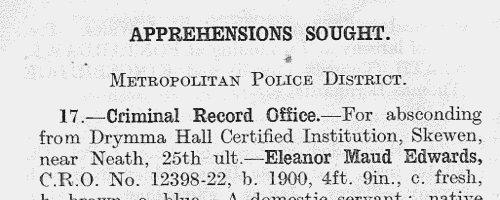
| Wanted by the police in the North Riding of Yorkshire
(1923)
The Police Gazette was published by Authority by the London Metropolitan Police, and circulated, as confidential, to the police forces throughout Britain and Ireland. The contents were based on the information routinely submitted to the Criminal Record Office. One of the regular features was a section entitled Apprehensions Sought, in which each police force gave details of people for whom arrest warrants had been issued and were now on their Wanted list. The details given are: the name of the police authority (in bold) seeking an arrest; a brief description of the crime; the suspect's full name (in bold); C. R. O. number, year of birth, height, complexion, hair colour, eye colour, distinguishing marks such as scars; clothing &c. There then follows a resume of previous convictions. Variations of surname spelling and aliases are noted in the descriptions, and these variants and aliases have also been indexed. | Sample scan, click to enlarge
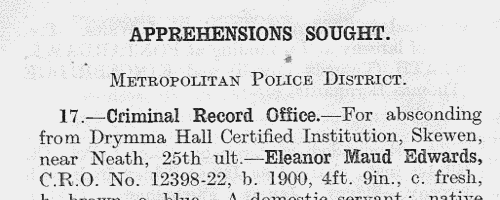
| Anglican clergy
(1930)
Crockford's Clerical Directory listed all Anglican clergy in the British Isles, India, the colonies, Europe, Asia and South America. The 59th annual issue, for 1930, is based on returns from all the individuals listed. The details given are: name (surname first, in capitals) in bold, prefixed by an asterisk in the case of university electors, and by a dagger whether the return had not been made, or it had been imperfectly filled up; name of theological college and/or university, and degrees, with years; a bold d followed by year and diocese signifies date of ordination as deacon and by which bishop; then a bold p, similarly for ordination as priest; posts (C: curate; I: incumbent; V; vicar; R: rector) with parishes and years; address; telephone number; and lists of books &c. where appropriate. In the case of the man then holding an English, Irish, Scottish or Welsh benefice, additional details are given - a bold P signifies the patron of the advowson; then the income, with items such as Q. A. B. (Queen Anne's Bounty), Eccles(iastical) Comm(issioners), Fees, e. o. (Easter Offerings), Pew Rents, T(ithe) R(ent) C(harge), Gl(ebe), &c. | Sample scan, click to enlarge

| Members of Oxford University: Men
(1931)
The Oxford University Calendar for 1931 includes this list of all living members of the university, i. e. not only undergraduates and members of staff, but also all surviving graduates from earlier generations. The names are arranged alphabetically by surname, then by college in order of foundation. Surnames are given, initials, highest degree, name of college, and then the year of graduating the first degree. For undergraduates only name and college is given. An asterisk before a surname indicates a member on the foundation of the college. There are separate lists for men and women. | Sample scan, click to enlarge
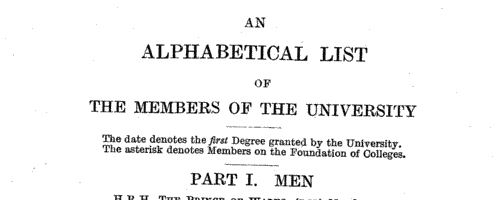
| Officers of the British Army and of the Indian Army
(1934)
The Half-Yearly Army List, issued By Authority, 30 June 1934, lists all officers in active service at that date, and this list was evidence of the status and rank of the officers contained in it. The entries are set out as a gradation list, by rank, from field-marshals to lieutenants, and within each rank in order of seniority at that rank. Each officer's name (surname first, in capitals, then christian name and present rank (with date of achieving that rank) and regiment &c. are given, for convenience, in bold type, with any national decorations in italics after the name. Each entry also gives date of birth, number of days service in the ranks, dates of service in each rank of officer, particular offices and postings (with dates) and, where appropriate, a summary of war service, and medals. For all but the oldest of the officers then serving, the war service details are for the Great War (1914-1921), and campaigns in Iraq, Waziristan, and the North West Frontier of India. War services are not given in this edition for Indian Army officers, except in that their entries are preceded by a crossed swords symbol where they have seen war service in a theatre of war overseas. After the gradation list of officers, there is a section for the Royal Malta Artillery; and then (pages 1152 to 1185) warrant officers - staff or garrison serjeant-majors, educational serjeant-majors, serjeant-major (physical training and educational) instructors, regimental serjeant-majors (and corporal-majors, farrier-serjeant majors, master gunners, assistant instructors in gunnery, experimental serjeant-majors, artillery clerks, farrier-serjeant-majors, artificer serjeant-majors, clerks of works, mechanist, superintending clerks, draughtsmen, 1st class staff serjeant-majors, transport, supply, conductors, sub-conductors, armourers, armament artificers, headmasters, schoolmasters, marine gunners, and bandmasters. The section for the Royal Army Chaplains' Department lists all chaplains (1st to 3rd class); and that for Queen Alexandra's Imperial Military Nursing Service has all matrons, sisters and staff nurses. The lists of nurses do not give date of birth: all are unmarried. The book concludes with the Yeomen of the Guard, the Honourable Company of Gentlemen-at-Arms, and the King's Body Guard for Scotland, in each case giving name (surname and initials, not christian names), honours, name of late regiment, and date of appointment.
| Sample scan, click to enlarge

| Student Mining Engineers (Stud. I. Min. E.)
(1949)
The Institution of Mining Engineers was established 1 July 1889 and incorporated by royal charter 9 February 1915. This list of members is corrected up to 28 December 1949. Five grades of members are listed: Honorary Members (Hon. M. I. Min. E.); Members (M. I. Min. E.); Associate Members (Assoc. M. I. Min. E.); Students (Stud. I. Min. E.); and Associates (Assoc. I. Min. E.). The grade of Associate comprised all persons who were registered as associates on 31 January 1933: every candidate for admission to that class after that date must be a person 'who is qualifying himself for the profession of mining engineering'. The members' names are listed alphabetically (in bold) by surname and christian name, with full address. On the right hand side are initials indicating to which federated institute he or she belonged: M. C., Midland Counties Institution of Engineers; M. G., Manchester Geological and Mining Society; M. I., Midland Institute of Mining Engineers; N. E., North of England Institute of Mining and Mechanical Engineers; N. S., North Staffordshire Institute of Mining Engineers; S. S., South Staffordshire and Warwickshire Institute of Mining Engineers; and S. W., the South Western Society of Mining Engineers. | Sample scan, click to enlarge
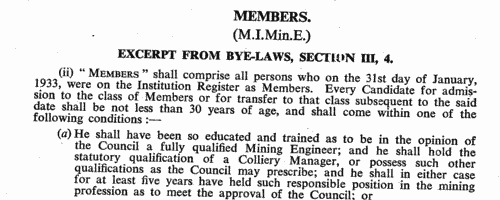
| Chemists
(1950)
The Royal Institute of Chemistry was founded in 1877, and was open only to British subjects (and also, in due course, to citizens of the newly-created Republic of Ireland). Associates of the institute (A. R. I. C.) qualified either by studying chemistry, physics, mathematics and an optional science for the institute's examination (which insisted on a high standard of practical laboratory efficiency); or by obtaining good honours degrees or equivalent qualifications, with chemistry as principal subject, and having undergone training in allied sciences. Associates of at least three years' standing could then be admitted to the Fellowship (F. R. I. C.) either by taking a further examination in a special branch of chemistry, or by submitting the results of work or evidence of experience sufficient to justify the Council in granting exemption from such further examination. This register of fellows and associates, correct to 31 August 1950, contains 11,545 names, arranged alphabetically, surname first (in capitals), with qualifications, current address, telephone number, and (in italics) a brief description of present post in the chemical industry. Finally, year of admission as associate (A.) (and, where appropriate, fellow (F.) is given on the right-hand side. With this may appear the notation (x) for a fellow of the Chemical Society, (y) for a member of the Society of Chemical Industry, or (z) for a joint subscriber to all three chartered bodies. | Sample scan, click to enlarge

| Owners and Breeders of Friesian Cattle
(1951)
The British Friesian Cattle Society registered the pedigrees of pure Friesian cattle in the United Kingdom. This list of members is corrected to 10 April 1951, and gives full name (surname first), address, and where the member owned a herd, the prefix attributed to that herd. A dagger in front of an entry indicates that the herd was attested. | Sample scan, click to enlarge

|
Research your ancestry, family history, genealogy and one-name study by direct access to original records and archives indexed by surname.
|











